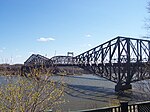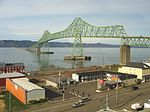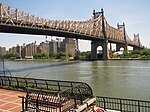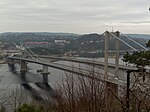
A cable-stayed bridge has one or more towers, from which cables support the bridge deck. A distinctive feature are the cables or stays, which run directly from the tower to the deck, normally forming a fan-like pattern or a series of parallel lines. This is in contrast to the modern suspension bridge, where the cables supporting the deck are suspended vertically from the main cable, anchored at both ends of the bridge and running between the towers. The cable-stayed bridge is optimal for spans longer than cantilever bridges and shorter than suspension bridges. This is the range within which cantilever bridges would rapidly grow heavier, and suspension bridge cabling would be more costly.

The Goethals Bridge is the name of a pair of cable-stayed bridge spans connecting Elizabeth, New Jersey, to Staten Island, New York, in the United States. The spans cross a strait known as Arthur Kill, and replaced a cantilever bridge span built in 1928. The bridge is operated by the Port Authority of New York and New Jersey.

The Quebec Bridge is a road, rail, and pedestrian bridge across the lower Saint Lawrence River between Sainte-Foy and Lévis, in Quebec, Canada. The project failed twice during its construction, in 1907 and 1916, at the cost of 88 lives and additional people injured. The bridge eventually opened in 1919.

Pulteney Bridge is a bridge over the River Avon in Bath, England. It was completed by 1774, and connected the city with the land of the Pulteney family which the family wished to develop. Designed by Robert Adam in a Palladian style, it is highly unusual in that it has shops built across its full span on both sides. It has been designated as a Grade I listed building.
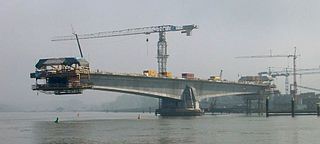
A cantilever bridge is a bridge built using structures that project horizontally into space, supported on only one end. For small footbridges, the cantilevers may be simple beams; however, large cantilever bridges designed to handle road or rail traffic use trusses built from structural steel, or box girders built from prestressed concrete.

A truss bridge is a bridge whose load-bearing superstructure is composed of a truss, a structure of connected elements, usually forming triangular units. The connected elements, typically straight, may be stressed from tension, compression, or sometimes both in response to dynamic loads. There are several types of truss bridges, including some with simple designs that were among the first bridges designed in the 19th and early 20th centuries. A truss bridge is economical to construct primarily because it uses materials efficiently.
The Isaiah David Hart Bridge is a truss bridge that spans the St. Johns River in Jacksonville, Florida. It carries U.S. Route 1 Alternate and State Road 228 (SR 228). It is named after Isaiah Hart, the founder of Jacksonville and is often referred to as the Hart Bridge. It was designed by Sverdrup & Parcel. The Hart Bridge is one of the longest truss bridges in the world, and has the world's third longest main span of any truss bridge.

The Silver Jubilee Bridge crosses the River Mersey and the Manchester Ship Canal at Runcorn Gap between Runcorn and Widnes in Halton, England. It is a through arch bridge with a main arch span of 361 yards. It was opened in 1961 as a replacement for the Widnes–Runcorn Transporter Bridge. In 1975–77 the carriageway was widened, after which the bridge was given its official name in honour of the Queen's Silver Jubilee. It carries the A533 road and a cantilevered footway. The bridge is recorded in the National Heritage List for England as a designated Grade II listed building. The bridge was closed to vehicles for refurbishment upon the opening of the new Mersey Gateway Bridge, but reopened as a toll bridge in February 2021.

The Howrah Bridge is a balanced steel bridge over the Hooghly River in West Bengal, India. Commissioned in 1943, the bridge was originally named the New Howrah Bridge, because it replaced a pontoon bridge at the same location linking the twin cities of Howrah and Kolkata, which are located at the opposite banks of each other. On 14 June 1965, it was renamed Rabindra Setu after the Bengali poet Rabindranath Tagore, who was the first Indian and Asian Nobel laureate. It is still popularly known as the Howrah Bridge.

An abutment is the substructure at the ends of a bridge span or dam supporting its superstructure. Single-span bridges have abutments at each end that provide vertical and lateral support for the span, as well as acting as retaining walls to resist lateral movement of the earthen fill of the bridge approach. Multi-span bridges require piers to support ends of spans unsupported by abutments. Dam abutments are generally the sides of a valley or gorge, but may be artificial in order to support arch dams such as Kurobe Dam in Japan.

The Varodd Bridges are two parallel cantilever bridges in Kristiansand municipality, in Agder county, Norway, and they cross the Topdalsfjorden. They are named after the peninsula on the western shore. It goes from Vige and ends in Søm in Kristiansand. The bridges carry the European route E18 highway over the fjord.

Main Channel Bridge (Winona) consists of a pair of bridges, the original cantilever bridge, and a concrete box girder bridge completed in 2016, that span the main channel of the Mississippi River in the United States between Winona, Minnesota, and Latsch Island. Another bridge, the North Channel Bridge, connects the island to rural Buffalo County, Wisconsin. The bridge carries Minnesota State Highway 43, which continues as Wisconsin Highway 54 at the Minnesota/Wisconsin state line on the nearby North Channel Bridge; in Winona, it connects to Winona Street.

The Mount Henry Bridge carries the Kwinana Freeway and Mandurah railway line over the Canning River in Perth, approximately 10 kilometres (6.2 mi) south of the Perth central business district. At 688 metres (2,257 ft) in length including abutments, it is the longest road bridge in Western Australia. It spans the river between the Mount Henry Peninsula and the suburb of Mount Pleasant.

The Stolma Bridge is a road bridge over the Stolmasundet strait in Austevoll municipality, Vestland county, Norway. It connects the islands of Stolmen and Selbjørn. The bridge is 467 metres (1,532 ft) long and has three spans, the largest of which is 301 metres (988 ft). The construction cost was US$15.3 million. The bridge was opened for traffic 14 November 1998 and is part of County Road 5138. The main span was the world's longest cantilever box-girder span until it was surpassed by the Shibanpo Second Yangtze River Bridge in China.
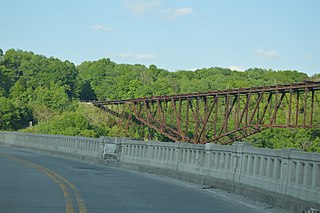
Young's High Bridge is a former railroad bridge near Tyrone, Kentucky, USA, that spans the Kentucky River between Anderson County, Kentucky and Woodford County, Kentucky for the Louisville Southern Railroad. The cantilever bridge, named in honor of William Bennett Henderson Young, was constructed in 1889, and the first train crossed over on August 24, 1889. The bridge is 1,659 feet in length, is 283 feet above the river, and includes a 551 foot long cantilever span.
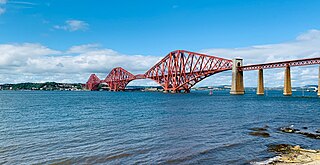
The Forth Bridge is a cantilever railway bridge across the Firth of Forth in the east of Scotland, 9 miles west of central Edinburgh. Completed in 1890, it is considered a symbol of Scotland, and is a UNESCO World Heritage Site. It was designed by English engineers Sir John Fowler and Sir Benjamin Baker. It is sometimes referred to as the Forth Rail Bridge, although this is not its official name.

The Hassayampa Bridge is a bridge spanning the Hassayampa River in Hassayampa, Arizona, located in Maricopa County. The bridge was completed in 1929 and was listed on the National Register of Historic Places in 1988. The bridge was scheduled for demolition in 1983.

The West Fifth Street Bridge is a historic cantilever concrete girder bridge in downtown Austin, Texas. Built in 1931, the bridge carries Fifth Street across Shoal Creek to link central Austin with neighborhoods that were then the city's western suburbs. It is one of only a handful of curved cantilever girder bridges in Texas, built as part of the city's 1928 master plan for urban development and beautification. The bridge was added to the National Register of Historic Places in 2019.
